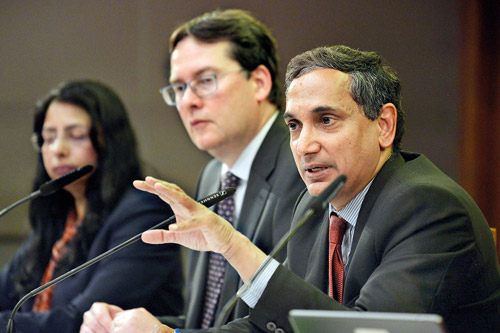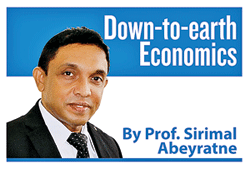“Stop going to the IMF”
View(s):
File picture of an IMF media conference in Colombo.
Sri Lanka has been a “repeated client” of the IMF. It has been there 17 times during the past 58 years – too long and too often. The first visit was in 1965 and the most recent one in 2023/24.
About 2 – 3 years ago Sri Lanka refused to go to the IMF and started seeking “home-grown” solutions to the problems at home. As Sri Lanka was waiting for a home-grown solution to drop down from somewhere, the problems got aggravated. It ended with a default; the country declared the suspension of repaying part of the foreign debt on April 12, 2022, and, finally, turned to the IMF.
Let’s take a look at what Bangladesh did. Bangladesh was doing well and comfortably building up its foreign exchange reserves during the COVID pandemic time. Even Sri Lanka which was faced with depleting foreign exchange reserves at the time, borrowed US$200 million from Bangladesh.
However after the COVID pandemic was over, the foreign reserves of Bangladesh which amounted to $48 billion in August 2021 started dwindling rapidly. It was caused by the Bangladesh Central Bank’s attempt to avoid exchange rate depreciation by selling foreign reserves. Foreign reserves dropped to $33 billion by the end of 2022.
Unlike Sri Lanka, Bangladesh did not wait until foreign reserves came down from billions to millions. It quickly approached the IMF and entered an agreement for a $4.7 billion loan in January 2023. It was a stabilisation package and not a ‘bailout’ package. However, the depletion of foreign reserves did not come to an end throughout the subsequent period; the amount left was just $24 billion by May 2024.
No dispute
I have no dispute about
Sri Lanka’s need to stop going to the IMF. But the question is how to do it. During the past few decades, there have been academic critiques over the role of the IMF and its loan conditionalities with respect to their negative repercussions in developing countries.
 However, there are 190 member countries of the IMF leaving only about five non-member countries in the world. IMF was the last resort for the member states at their financial distress related to external finance issues,
However, there are 190 member countries of the IMF leaving only about five non-member countries in the world. IMF was the last resort for the member states at their financial distress related to external finance issues,
budgetary disorders, and the public debt problem.
Some may even argue that it is the IMF strategy to keep countries like Sri Lanka coming back to it repeatedly. Whatever, the truth is in a statement, actually, there are a handful of countries such as Cuba and North Korea which have never gone to the IMF as they didn’t want to become IMF members.
Sri Lanka became an IMF member state as early as in 1950 – just six years after the establishment of the IMF following the Bretton Woods Conference in 1944. As the country’s foreign exchange reserves depleted and the budgetary position worsened, Sri Lanka became a frequent visitor to the IMF, starting from 1965.
There are some IMF member countries which have stopped going to the IMF. Let’s examine the case of two such countries to understand how they stopped being repeated clients of the IMF.
India
As India was approaching the last phase of its regulated policy regime with import controls, it had deeper economic turmoil with rampant poverty. The country suffered from the twin-deficit problem – current account deficit due to foreign exchange shortage and the government’s budget deficit due to revenue-expenditure gap.
As the country was so far focusing on “import substitution”, India’s total export earnings were as small as $18 billion in 1990. The fixed exchange rate of the Indian rupee was unmanageable and had to be devalued. India also took steps to sell its gold reserves to the UK. With India’s foreign exchange reserves at $1.5 billion which were barely enough to finance about three weeks of essential imports. India was nearing a default of its external debt.
India approached the IMF in 1991 and secured $2.2 billion emergency loan. At the same time under the new government, India initiated its trade liberalisation reforms abandoning its 40-year-old regulated economic model.
Today, India is a $3.5 trillion economy, which is more than 10 times bigger than it was 30 years ago. It accelerated its rate of GDP growth to reach 7 – 8 per cent a year, in most of the years after 2000. Exports increased from $18 billion in 1990 to $453 billion in 2022.
And it was the last time that India went to the IMF. A few weeks ago, India moved its 100 tonnes of Gold Reserves from UK back to India, for the first time since 1991.
Thailand
It was the beginning of the East Asian Financial Crisis that spread across East and Southeast Asian countries with ripple effects. It started in Thailand with the collapse of its currency, Thai Bhat, against the US dollar.
The exchange rate, which was 26 Thai Bhat per US dollar suddenly depreciated reaching 56 Bhat per US dollar as foreign exchange outflow from the stock exchange and security markets got accelerated. As a result of the crisis, businesses collapsed, asset prices plummeted, debt burden rose, and unemployment skyrocketed. It triggered chain reactions in other countries causing panic in foreign exchange markets and resulting in the same outcomes.
While the crisis lasted for three years, Thailand made a remarkable recovery supported by the IMF. The IMF provided a $3.9 billion assistance package with conditions related to monetary policy tightening and structural reforms. The Thai government also adopted tough policy measures for fiscal consolidation including tax hikes and reforms needed for export growth.
The Thai GDP which was $183 billion prior to the crisis contracted to $113 billion in 1998. As a result of the reform process, it started rising, and increased to over $500 billion by 2020. About $55 billion exports rose to $287 billion by 2022. While maintaining the policy reform process in achieving higher export growth, Thailand did not seek IMF assistance anymore.
Stability and progress
There are two keys which can help a country to stop going to the IMF and to keep the door closed: economic stability and economic progress. The experience of both India and Thailand shows that their unwavering reform process helped them to achieve and sustain economic stability and economic progress. Accordingly, they were able to stop going to the IMF.
What has happened to Sri Lanka is that every time when the economy was in financial distress it went to the IMF. But every time there was no continuity in the reform process to ensure economic stability and economic progress. In particular, when there were elections round the corner, the reform process got diluted so that stability and progress were never sustained.
Since the time that Sri Lanka entered the IMF programme in the aftermath of the economic crisis, the reform agenda has been implemented in order to improve economic stability. Apart from debt restructuring, economic stability must be achieved through fiscal consolidation and monetary discipline on the one hand and, thereby stabilising prices, interest rates and exchange rates.
Challenges ahead
Sri Lanka has shown some progress in achieving economic stability, although it has a cost to the people who were already battered by the economic crisis. However, ultimately economic stability must be sustained. In addition, people too must be able to relieve their burden and begin to achieve higher living standards. They all depend on the second key – economic progress.
It is also not just economic progress, but economic progress linked to export growth and investment promotion. Since Sri Lanka has given up reforms in this particular area of export growth and investment promotion for decades, there is a set of wider and broader reforms that the country has to adopt as quickly as possible. And it has an adjustment cost too which could result in obstacles to reforms.
Such reforms must result in an establishment of a better environment conducive to export growth and investment promotion on the one hand and facilitating the building of investor confidence on the other hand. But here is the major challenge: elections are round the corner again. Only if the reform process continues through the elections, before and after, like in India and Thailand, that Sri Lanka can hope to stop going to the IMF again.
(The writer is Emeritus Professor of Economics at the University of Colombo and can be reached at sirimal@econ.cmb.ac.lk and follow on Twitter @SirimalAshoka).
Hitad.lk has you covered with quality used or brand new cars for sale that are budget friendly yet reliable! Now is the time to sell your old ride for something more attractive to today's modern automotive market demands. Browse through our selection of affordable options now on Hitad.lk before deciding on what will work best for you!


